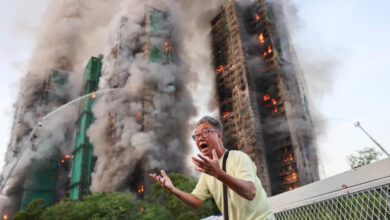
SHAVER LAKE, Calif. (AP) — Wildfires raged unchecked throughout California Wednesday, and gusty winds could drive flames into new ferocity, authorities warned.
Diablo winds in the north and Santa Ana winds in the south were forecast into Wednesday at a time when existing wildfires already have grown explosively.
On Tuesday, 14 firefighters were forced to deploy emergency shelters as flames overtook them and destroyed the Nacimiento Station, a fire station in the Los Padres National Forest on the state’s central coast, the US Forest Service said. They suffered from burns and smoke inhalation, and three were flown to a hospital in Fresno, where one was in critical condition.
In the past two days, helicopters were used to rescue hundreds of people stranded in the burning Sierra National Forest, where the Creek Fire has destroyed 365 buildings, including at least 45 homes, and 5,000 structures were threatened, fire officials said.
Flames threatened the foothill community of Auberry between Shaver Lake and Fresno.
In Southern California, fires burned in Los Angeles, San Bernardino and San Diego counties, and the forecast called for the arrival of the region’s notorious Santa Anas. The hot, dry winds could reach 50 mph at times, forecasters said.
People in a half-dozen foothill communities east of Los Angeles were being told to stay alert because of a fire in the Angeles National Forest.
“The combination of gusty winds, very dry air, and dry vegetation will create critical fire danger,” the National Weather Service warned.
The U.S. Forest Service on Monday decided to close all eight national forests in the southern half of the state and shutter campgrounds statewide.
More than 14,000 firefighters are battling fires. Two of the three largest blazes in state history are burning in the San Francisco Bay Area, though they are largely contained after burning three weeks.
California has already set a record with nearly 2.3 million acres (930,800 hectares) burned this year — surpassing a record set just two years ago — and the worst part of the wildfire season is just beginning.
“It’s extraordinary, the challenge that we’ve faced so far this season,” Gov. Gavin Newsom said.
The threat of winds tearing down power lines or hurling debris into them and sparking a wildfire prompted Pacific Gas & Electric, the state’s largest utility, to shut off power to 172,000 customers over the weekend. More outages were expected Wednesday, with power not expected to be completely restored until Wednesday night.
To the south, Southern California Edison warned roughly 55,000 customer accounts may lose power while San Diego Gas & Electric said 16,700 customers are at risk of a preemptive outage.
In the Sierra National Forest east of Fresno, dozens of campers and hikers were stranded at the Vermilion Valley Resort after the only road in — a narrow route snaking along a steep cliff — was closed Sunday because of the Creek Fire.
Well before dawn Tuesday, the sound of helicopter blades chopping through the air awoke Katelyn Mueller, bringing relief after two anxious nights camping in the smoke.
“It was probably the one time you’re excited to hear a helicopter,” Mueller said. “You could almost feel a sigh of relief seeing it come in.”
The use of military helicopters to rescue a large number of civilians for a second day — 164 before dawn Tuesday and 214 people from a wooded camping area on Saturday — is rare, if not unprecedented.
“This is emblematic of how fast that fire was moving, plus the physical geography of that environment with one road in and one road out,” said Char Miller, a professor of environmental analysis at Pomona College who has written extensively about wildfires. “Unless you wanted an absolute human disaster, you had to move fast.”
Numerous studies in recent years have linked bigger wildfires in America to global warming from the burning of coal, oil and gas, especially because climate change has made California much drier. A drier California means plants are more flammable.
“The frequency of extreme wild fire weather has doubled in California over the past four decades, with the main driver being the effect of rising temperature on dry fuels, meaning that the fuel loads are now frequently at record or near-record levels when ignition occurs and when strong winds blow,” Stanford University climate scientist Noah Diffenbaugh said in an email.
___
Melley reported from Los Angeles. Associated Press writers Christopher Weber, Frank Baker and John Antczak in Los Angeles, Olga Rodriguez and Juliet Williams in San Francisco and Seth Borenstein in Washington contributed.
Image: Property is left in ruins after the Creek Fire passed through Tuesday, Sept. 8, 2020, in Tollhouse, Calif. (AP Photo/Marcio Jose Sanchez)




